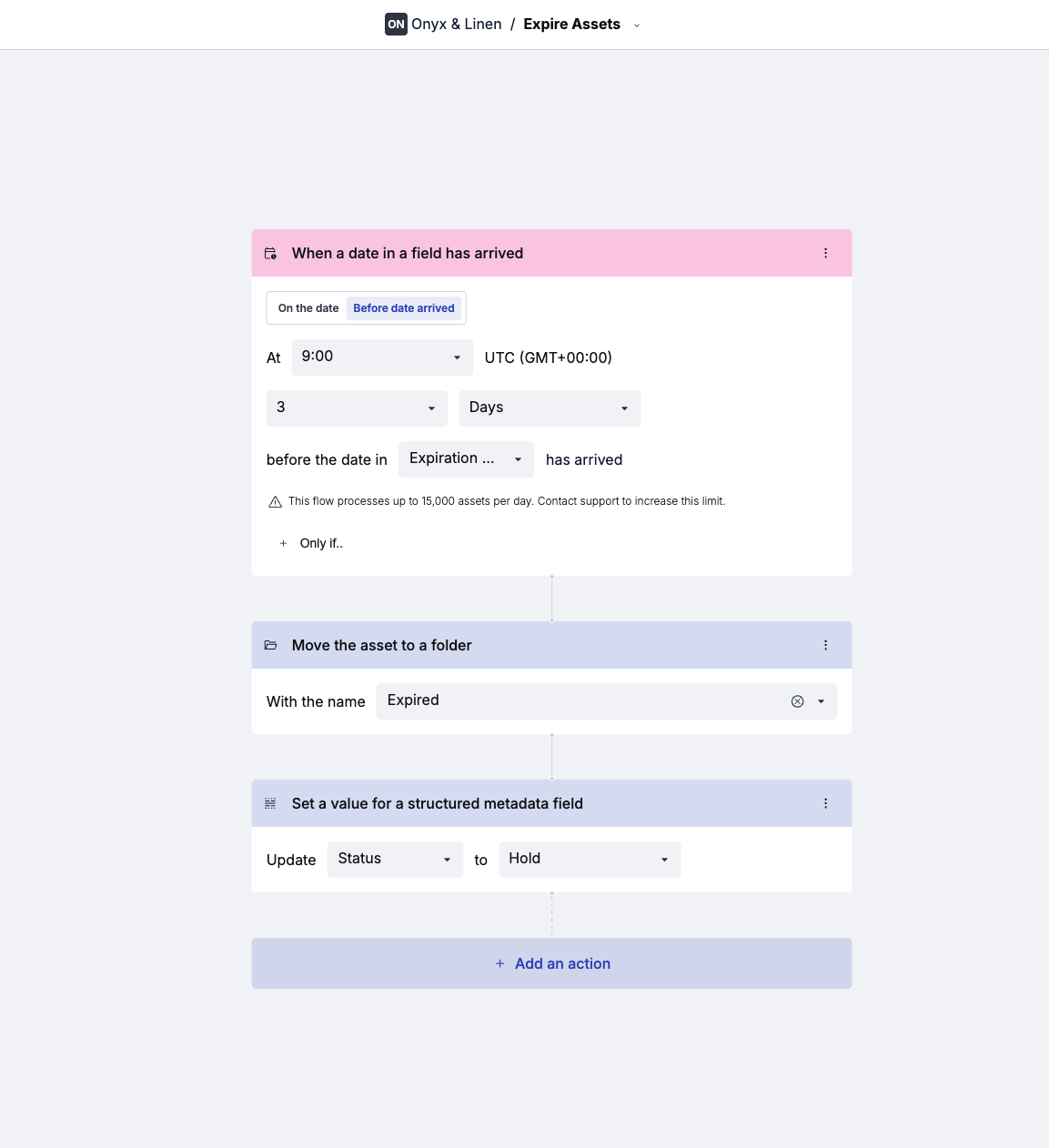Creating new visual assets is fun. New creatives, campaigns, promotions are always satisfying.
But maintaining it all afterwards isn’t. Repetitive tasks, like adding alt text, content moderation, and asset renewals, pile up, wasting time and effort that could have been better spent on more valuable tasks. Syncing with other tools in your visual media stack can also be cumbersome and error-prone. In some cases, teams avoid doing these tasks altogether, with a resulting drop in overall quality.
Workflow automation in your DAM can solve a lot of these problems. Let’s use asset expiration as an example.
In general, media assets shouldn’t be used forever. They age: Sometimes the license on the image expires, the campaign becomes irrelevant, new images need to replace older ones, etc.
In all these cases, images need to be removed and archived, so they won’t appear where they shouldn’t be.
Managing asset expiration might sound like a simple use case — the asset date should appear in the metadata, and these images should be discovered and replaced. But in reality, every company handles it differently. The business logic varies on issues such as how expiration is defined and what should happen when an asset reaches the end of its life.

No matter the company and its process, something needs to happen when an asset expires:
- Some companies prefer to take action at the moment an asset expires, e.g., restricting delivery or removing access.
- Others want to be proactive, setting up flows that trigger before expiration to allow for human review.
In any case, we’d need:
- Notifications about an asset’s expiration.
- Changes to the asset’s delivery status, tags, folder, etc.
And much more.
Doing all this manually is time-consuming, although there can be cases where you’d want to add a human-in-the-loop step for review.
So how do you automate the process of managing asset expiration?
MediaFlows, Cloudinary’s workflow automation engine, enables you to build automations for your unique asset management needs. Whether you need a basic rule or a complex multi-step process, MediaFlows gives you the flexibility to create the flow that fits your business.
With MediaFlows, you can go over the asset’s expiry_date metadata and set the right actions to happen at the right time.
Some real-world examples you can easily implement with MediaFlows:
- Two weeks before expiration. Trigger a notification to relevant stakeholders (e.g., legal, marketing, brand) via email, Slack, Teams, or another service.
- On expiration:
- Restrict delivery status from “public” to “restricted”.
- Add an “expired” tag or metadata field.
- Move the asset to a restricted folder.
- Overlay a watermark using Cloudinary’s transformation capabilities.
- Delete the asset completely, if it’s no longer needed.
- Push the asset to cold storage like S3, using MediaFlows’ external storage integration.
- Post expiration. Trigger a second-level alert or archive reminder, depending on the asset status.
Not all expiration actions have to be automated. MediaFlows also supports approval-style workflows through:
- Notifications (email, Slack, Teams, etc.).
- Moving flagged assets into review folders.
- Adding metadata or tags that help teams identify which assets need review before taking action.
This gives teams the option to keep a human in the loop, while still benefiting from automation.
Even without direct access to usage metrics, MediaFlows lets you create conditional behavior based on any available metadata field. For example:
- If an asset has status: homepage, it can be treated differently from assets in a dormant state.
- If an asset is marked as campaign: active, extend its expiry or delay its removal.
This flexibility lets you enforce smarter policies, even in the absence of deeper usage analytics.
Workflow automation isn’t just about eliminating repetitive tasks. It gives marketers, SEO teams, designers, and even developers the ability to create the automations they need without coding. We’ve even seen system architects prefer MediaFlows to coding.
MediaFlows has two options, depending on the user and the needs:
- EasyFlows. A simple, guided no-code creator.
- PowerFlows. A low-code option for more advanced workflows.
Whether you’re a nontechnical DAM admin or a developer managing large-scale workflows:
- EasyFlows’ no-code interface makes it easy to set up expiration rules, tag assets, and trigger notifications.
- PowerFlows’ low-code environment supports branching logic, loops, external integrations, and advanced business rules.
MediaFlows scales with your needs, allowing teams across your organization to build, own, and evolve asset governance workflows.
By using a workflow engine like MediaFlows to manage asset expiration, you ensure:
- Flexibility. Build flows that match your company’s unique policies and processes.
- Reliability. Automations run consistently, without the risk of human error.
- Scalability. As your asset library and business complexity grow, your flows grow with you.
- Visibility. Every automation is traceable, helping you maintain control and compliance.
Whether you’re handling a few assets or thousands, MediaFlows gives you the peace of mind that expired content won’t stay published or get forgotten.
Try MediaFlows by Cloudinary today. It’s accessible in the console, and you can choose either EasyFlows or PowerFlows, depending on what you’d like to build.



